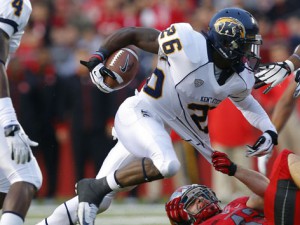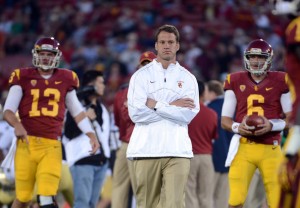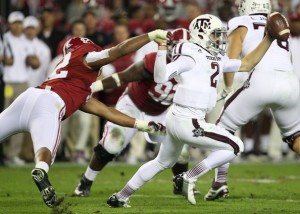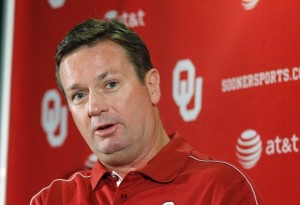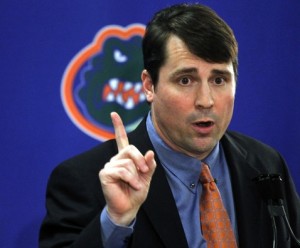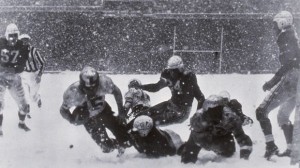I didn’t publish my college football SRS ratings last week, but with the conclusion of yesterday’s Army-Navy game, the college football regular season is over. But before we turn our attention to the Bowls, here is a look at the final regular season SRS ratings.
| Rk | Team | Conf | Conf Rk | G | MOV | SOS | SRS | REC |
|---|---|---|---|---|---|---|---|---|
| 1 | Oregon | P12 | 1 | 12 | 23.7 | 41.4 | 65.1 | 11-1 |
| 2 | Alabama | SEC | 1 | 13 | 22.8 | 41.3 | 64.1 | 12-1 |
| 3 | Texas A&M | SEC | 2 | 12 | 18.2 | 42.4 | 60.6 | 10-2 |
| 4 | Kansas St | B12 | 1 | 12 | 16.5 | 43.2 | 59.7 | 11-1 |
| 5 | Florida | SEC | 3 | 12 | 13.1 | 44.4 | 57.5 | 11-1 |
| 6 | Notre Dame | IND | -- | 12 | 14.7 | 42.8 | 57.5 | 12-0 |
| 7 | Georgia | SEC | 4 | 13 | 15.8 | 41.5 | 57.3 | 11-2 |
| 8 | Oklahoma | B12 | 2 | 12 | 13.5 | 43.7 | 57.3 | 10-2 |
| 9 | Stanford | P12 | 2 | 13 | 10 | 45.4 | 55.4 | 11-2 |
| 10 | South Carolina | SEC | 5 | 12 | 12.5 | 41.9 | 54.4 | 10-2 |
| 11 | LSU | SEC | 6 | 12 | 11.4 | 42.8 | 54.1 | 10-2 |
| 12 | Oregon St | P12 | 3 | 12 | 9.6 | 44 | 53.6 | 9-3 |
| 13 | Oklahoma St | B12 | 3 | 12 | 11.1 | 42.5 | 53.6 | 7-5 |
| 14 | Southern Cal | P12 | 4 | 12 | 7.9 | 44.5 | 52.4 | 7-5 |
| 15 | Florida St | ACC | 1 | 13 | 19.3 | 32.6 | 52 | 11-2 |
| 16 | Ohio State | B10 | 1 | 12 | 13.7 | 38.3 | 51.9 | 12-0 |
| 17 | Baylor | B12 | 4 | 12 | 5.1 | 45.9 | 51 | 7-5 |
| 18 | Texas | B12 | 5 | 12 | 6.1 | 44.5 | 50.6 | 8-4 |
| 19 | Wisconsin | B10 | 2 | 13 | 9.9 | 40.7 | 50.6 | 8-5 |
| 20 | Clemson | ACC | 2 | 12 | 15.1 | 35.5 | 50.6 | 10-2 |
| 21 | Arizona St | P12 | 5 | 12 | 9.2 | 41.3 | 50.5 | 7-5 |
| 22 | UCLA | P12 | 6 | 13 | 7.9 | 42.6 | 50.5 | 9-4 |
| 23 | Utah St | WAC | 1 | 12 | 17.7 | 32.1 | 49.8 | 10-2 |
| 24 | Michigan | B10 | 3 | 12 | 9 | 40.3 | 49.2 | 8-4 |
| 25 | Fresno St | MWC | 1 | 12 | 16 | 33.2 | 49.2 | 9-3 |
| 26 | Brigham Young | IND | -- | 12 | 11.7 | 36.1 | 47.8 | 7-5 |
| 27 | Arizona | P12 | 7 | 12 | 2.4 | 44.6 | 47 | 7-5 |
| 28 | Nebraska | B10 | 4 | 13 | 7.3 | 39.5 | 46.9 | 10-3 |
| 29 | Texas Tech | B12 | 6 | 12 | 4.4 | 42.2 | 46.6 | 7-5 |
| 30 | TCU | B12 | 7 | 12 | 4.9 | 41.4 | 46.4 | 7-5 |
| 31 | Penn State | B10 | 5 | 12 | 8.7 | 37.5 | 46.2 | 8-4 |
| 32 | San José St | WAC | 2 | 12 | 12.7 | 33.4 | 46.1 | 10-2 |
| 33 | Vanderbilt | SEC | 7 | 12 | 9.3 | 36.6 | 45.9 | 8-4 |
| 34 | West Virginia | B12 | 8 | 12 | 2.3 | 43.5 | 45.8 | 7-5 |
| 35 | Boise St | MWC | 2 | 12 | 13.8 | 31.8 | 45.7 | 10-2 |
| 36 | Northern Illinois | MAC | 1 | 13 | 18.5 | 27 | 45.5 | 12-1 |
| 37 | Northwestern | B10 | 6 | 12 | 7.6 | 37.4 | 45 | 9-3 |
| 38 | Iowa St | B12 | 9 | 12 | 0.8 | 44.1 | 44.9 | 6-6 |
| 39 | Mississippi | SEC | 8 | 12 | 1.2 | 43.7 | 44.9 | 6-6 |
| 40 | Mississippi St | SEC | 9 | 12 | 6 | 38.3 | 44.3 | 8-4 |
| 41 | Michigan St | B10 | 7 | 12 | 3 | 41.3 | 44.3 | 6-6 |
| 42 | Washington | P12 | 8 | 12 | 0.5 | 43.6 | 44.1 | 7-5 |
| 43 | Cincinnati | BgE | 1 | 12 | 12.3 | 31.2 | 43.5 | 9-3 |
| 44 | Missouri | SEC | 10 | 12 | -3.3 | 46.7 | 43.4 | 5-7 |
| 45 | Louisiana Tech | WAC | 3 | 12 | 11.8 | 31.3 | 43.1 | 9-3 |
| 46 | Central Florida | CUS | 1 | 13 | 11.4 | 31.5 | 42.9 | 9-4 |
| 47 | San Diego St | MWC | 3 | 12 | 9.8 | 32.6 | 42.4 | 9-3 |
| 48 | North Carolina | ACC | 3 | 12 | 11 | 31.3 | 42.4 | 8-4 |
| 49 | Utah | P12 | 9 | 12 | 0 | 42 | 41.9 | 5-7 |
| 50 | Syracuse | BgE | 2 | 12 | 3.5 | 38 | 41.5 | 7-5 |
| 51 | Tulsa | CUS | 2 | 13 | 9.3 | 32 | 41.3 | 10-3 |
| 52 | Arkansas St | Sun | 1 | 12 | 9.7 | 31.4 | 41.1 | 9-3 |
| 53 | Miami FL | ACC | 4 | 12 | 1.6 | 39.3 | 40.9 | 7-5 |
| 54 | Tennessee | SEC | 11 | 12 | -0.4 | 40.7 | 40.4 | 5-7 |
| 55 | Pittsburgh | BgE | 3 | 12 | 6.3 | 33.8 | 40.1 | 6-6 |
| 56 | Louisville | BgE | 4 | 12 | 7.1 | 32.9 | 40 | 10-2 |
| 57 | Georgia Tech | ACC | 5 | 13 | 2.9 | 36.9 | 39.8 | 6-7 |
| 58 | Rutgers | BgE | 5 | 12 | 8.1 | 31.6 | 39.7 | 9-3 |
| 59 | Louisiana-Monroe | Sun | 2 | 12 | 7.2 | 32.2 | 39.4 | 8-4 |
| 60 | Louisiana-Lafayette | Sun | 3 | 12 | 7.3 | 32 | 39.3 | 8-4 |
| 61 | Kent St | MAC | 2 | 13 | 10.1 | 29.2 | 39.3 | 11-2 |
| 62 | Purdue | B10 | 8 | 12 | 0 | 38.4 | 38.3 | 6-6 |
| 63 | Arkansas | SEC | 12 | 12 | -5.9 | 44.1 | 38.2 | 4-8 |
| 64 | North Carolina St | ACC | 6 | 12 | 3.2 | 34.5 | 37.7 | 7-5 |
| 65 | California | P12 | 10 | 12 | -9.1 | 46.4 | 37.3 | 3-9 |
| 66 | Virginia Tech | ACC | 7 | 12 | 0.8 | 36.4 | 37.2 | 6-6 |
| 67 | Ball St | MAC | 3 | 12 | 4.9 | 31.8 | 36.7 | 9-3 |
| 68 | Iowa | B10 | 9 | 12 | -4 | 40.5 | 36.5 | 4-8 |
| 69 | Toledo | MAC | 4 | 12 | 5.5 | 30.9 | 36.4 | 9-3 |
| 70 | SMU | CUS | 3 | 12 | 2 | 34.1 | 36 | 6-6 |
| 71 | Minnesota | B10 | 10 | 12 | -2.7 | 37.5 | 34.8 | 6-6 |
| 72 | Nevada | MWC | 4 | 12 | 3.3 | 31.2 | 34.4 | 7-5 |
| 73 | Western Kentucky | Sun | 4 | 12 | 2.7 | 31.3 | 34 | 7-5 |
| 74 | Navy | IND | -- | 12 | 2.7 | 31.2 | 33.9 | 8-4 |
| 75 | Auburn | SEC | 13 | 12 | -9.6 | 43.3 | 33.6 | 3-9 |
| 76 | Duke | ACC | 8 | 12 | -3 | 36.2 | 33.3 | 6-6 |
| 77 | Bowling Green | MAC | 5 | 12 | 7.6 | 25.5 | 33.1 | 8-4 |
| 78 | Indiana | B10 | 11 | 12 | -4.3 | 37.3 | 33 | 4-8 |
| 79 | Middle Tennessee St | Sun | 5 | 12 | 0.5 | 31.8 | 32.2 | 8-4 |
| 80 | Troy | Sun | 6 | 12 | -0.3 | 32.3 | 32 | 5-7 |
| 81 | East Carolina | CUS | 4 | 12 | 1.4 | 30.5 | 31.9 | 8-4 |
| 82 | Washington St | P12 | 11 | 12 | -11.8 | 43.5 | 31.7 | 3-9 |
| 83 | Virginia | ACC | 9 | 12 | -6.1 | 37.3 | 31.2 | 4-8 |
| 84 | Kansas | B12 | 10 | 12 | -16.1 | 47.1 | 31.1 | 1-11 |
| 85 | South Florida | BgE | 6 | 12 | -7 | 37.9 | 31 | 3-9 |
| 86 | Kentucky | SEC | 14 | 12 | -12.4 | 43.3 | 31 | 2-10 |
| 87 | Rice | CUS | 5 | 12 | 0.2 | 30.6 | 30.7 | 6-6 |
| 88 | Connecticut | BgE | 7 | 12 | -2.5 | 32.8 | 30.3 | 5-7 |
| 89 | Ohio U. | MAC | 6 | 12 | 5.2 | 24.7 | 29.9 | 8-4 |
| 90 | Air Force | MWC | 5 | 12 | 0.4 | 29.4 | 29.8 | 6-6 |
| 91 | Maryland | ACC | 10 | 12 | -6.4 | 35.9 | 29.4 | 4-8 |
| 92 | Temple | BgE | 8 | 11 | -6.7 | 35.5 | 28.8 | 4-7 |
| 93 | Boston College | ACC | 11 | 12 | -9.4 | 38.2 | 28.8 | 2-10 |
| 94 | Houston | CUS | 6 | 12 | -3.5 | 32 | 28.5 | 5-7 |
| 95 | Marshall | CUS | 7 | 12 | -2.4 | 30.3 | 27.9 | 5-7 |
| 96 | Texas St-San Marcos | WAC | 4 | 12 | -4 | 31.9 | 27.9 | 4-8 |
| 97 | Wyoming | MWC | 6 | 12 | -6.8 | 34.4 | 27.6 | 4-8 |
| 98 | Western Michigan | MAC | 7 | 12 | -1.8 | 29.2 | 27.4 | 4-8 |
| 99 | Colorado St | MWC | 7 | 12 | -8.6 | 35.5 | 26.9 | 4-8 |
| 100 | UTEP | CUS | 8 | 12 | -7.8 | 34.4 | 26.6 | 3-9 |
| 101 | Florida Int'l | Sun | 7 | 12 | -6.8 | 33.3 | 26.5 | 3-9 |
| 102 | Florida Atlantic | Sun | 8 | 12 | -8.7 | 35.1 | 26.4 | 3-9 |
| 103 | North Texas | Sun | 9 | 12 | -6.3 | 32.7 | 26.4 | 4-8 |
| 104 | New Mexico | MWC | 8 | 13 | -4.8 | 30.5 | 25.6 | 4-9 |
| 105 | Wake Forest | ACC | 12 | 12 | -11.5 | 37.1 | 25.6 | 5-7 |
| 106 | Central Michigan | MAC | 8 | 12 | -3.5 | 28.6 | 25.1 | 6-6 |
| 107 | Illinois | B10 | 12 | 12 | -14.7 | 39.3 | 24.6 | 2-10 |
| 108 | Buffalo | MAC | 9 | 12 | -7 | 31.1 | 24.1 | 4-8 |
| 109 | Memphis | CUS | 9 | 12 | -6 | 29.9 | 23.9 | 4-8 |
| 110 | Texas-San Antonio | WAC | 5 | 12 | 2.6 | 21 | 23.5 | 8-4 |
| 111 | Alabama-Birmingham | CUS | 10 | 12 | -8.6 | 32 | 23.4 | 3-9 |
| 112 | UNLV | MWC | 9 | 13 | -10.6 | 33.8 | 23.2 | 2-11 |
| 113 | Miami OH | MAC | 10 | 12 | -9.8 | 32.3 | 22.5 | 4-8 |
| 114 | Colorado | P12 | 12 | 12 | -22.9 | 44.6 | 21.8 | 1-11 |
| 115 | Hawai`i | MWC | 10 | 12 | -12.3 | 33.9 | 21.6 | 3-9 |
| 116 | Army | IND | -- | 12 | -11.6 | 33.1 | 21.5 | 2-10 |
| 117 | South Alabama | Sun | 10 | 13 | -10.8 | 30.5 | 19.6 | 2-11 |
| 118 | Akron | MAC | 11 | 12 | -10 | 29.4 | 19.4 | 1-11 |
| 119 | Eastern Michigan | MAC | 12 | 12 | -14.6 | 34 | 19.4 | 2-10 |
| 120 | Tulane | CUS | 11 | 12 | -15.5 | 33.8 | 18.3 | 2-10 |
| 121 | Southern Miss | CUS | 12 | 12 | -17.8 | 34.2 | 16.4 | 0-12 |
| 122 | Idaho | WAC | 6 | 12 | -21.6 | 36.7 | 15.1 | 1-11 |
| 123 | New Mexico St | WAC | 7 | 12 | -18.5 | 32.5 | 13.9 | 1-11 |
| 124 | Massachusetts | MAC | 13 | 12 | -22.3 | 32.1 | 9.9 | 1-11 |
I’ve also updated the NCAA Games page, which displays every game in major college football this season.
The table below lists the Bowl matchups along with some SRS data squeezed in: the last four columns show the SRS rating of the favorite and the underdog, along with the difference between the two ratings (i.e., a projected point spread) and the average of the two ratings (essentially a ranking of how good the game is).
[continue reading…]


